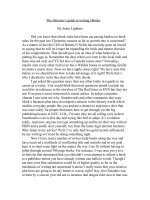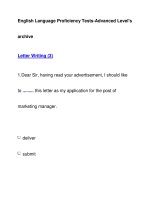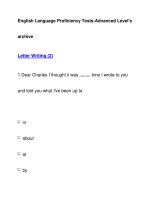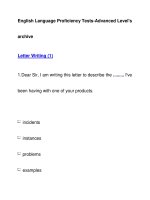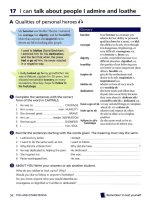Advanced writing ebook
Bạn đang xem bản rút gọn của tài liệu. Xem và tải ngay bản đầy đủ của tài liệu tại đây (2.25 MB, 193 trang )
ADVANCED
WRITING
Parviz Birjandi, PhD
Allameh Tabatabaii University
Seyyed Mohammad Alavi, PhD
University of Tehran
Mohammad Ali Salmani-Nodoushan, PhD
University of Zanjan
ZABANKADEH PUBLICATIONS
No. 8, Bazarcheh Ketaab, Enghelab Avenue, Tehran, Iran
E-Mail:
Phone: 0098-21-66402367
Fax: 0098-21-66492961
© 2004 by Zabankadeh Publications
No 8, Bazarcheh Ketaab, Enghelab Sq., Tehran
Tel: 0098-21-66402367 Fax: 0098-21-66492961
E-Mail: info@ zabankadeh.net
P.O. Box: 13145-564 Tehran, Iran
All rights reserved. No part of this book may be reproduced in any form or by
any means without permission in writing from Zabankadeh Publications.
Advanced Writing
Authors: Parviz Birjandi, PhD
Seyyed Mohammad Alavi, PhD
Mohammad Ali Salmani-Nodoushan, PhD
Printed in Iran
Birjandi, Parviz
ﺰﻳوﺮﭘ ،يﺪﻨﺟﺮﻴﺑ1319
)ﮓﻨﻴﺘﻳار ﺪﺴﻧود
ا
(
Advanced Writing / Parviz Birjandi, Mohammad Alavi,
Mohammad Ali Salmani-Nodoushan.ـ
1383=2004هﺪﻜﻧﺎﺑز ،م :ناﺮﻬﺗ
IX ، 181ص
.
ISBN 964-6117-51-1
ﻲﺴﻴﻠﮕﻧ
ا
.
ﺎﭙﻴﻓ تﺎﻋﻼﻃا سﺎﺳا ﺮﺑ ﻲﺴﻳﻮﻨﺘﺳﺮﻬﻓ.
1
.
ﻲﺴﻴﻠﮕﻧا نﺎﺑ
ز
ﻌﻣ نﺎﻴﺑ و ﻲﻧ
ﺎ
.
2
.
ﻲﻫﺎﮕﺸﻧاد ﻲﺴﻳﻮﻧ شراﺰ
ﮔ
.
ﻒﻟا
.
،ﺪﻤﺤﻣ ،يﻮﻠﻋ1339-
Salmani-Nodoushan,
ب
.
،ﻲﻠﻋﺪﻤﺤﻣ ،ﻦﺷوﺪﻧ ﻲﻧﺎﻤﻠﺳ1348-
Alavi, Mohammad.
Mohammad Ali.
ج
.ناﻮﻨﻋ: Advanced Writing
042/ 808 4 ﻒﻟا 84ب /1408PE
1383
9616-83م
ناﺮﻳا ﻲﻠﻣ ﻪﻧﺎﺨﺑﺎﺘ
ﻛ
Advanced Writing
نﺎﻔﻟﻮﻣ : يﺪﻨﺟﺮﻴﺑ ﺰﻳوﺮﭘ ﺮﺘﻛد / يﻮﻠﻋ ﺪﻤﺤﻣ ﺪﻴﺳ ﺮﺘﻛد /ﻦﺷوﺪُﻧ ﻲﻧﺎﻤﻠﺳ ﻲﻠﻋﺪﻤﺤﻣ ﺮﺘﻛد
هﺪﻜﻧﺎﺑز تارﺎﺸﺘﻧا
پﺎﭼمﻮﺳ 1384 ژاﺮﻴﺗ ،5000ﺎﺒﻳد پﺎﭼ ،ﻪﺨﺴﻧ
ﺪﺷﺎﺑ ﻲﻣ ظﻮﻔﺤﻣ هﺪﻜﻧﺎﺑز تارﺎﺸﺘﻧا ياﺮﺑ قﻮﻘﺣ ﻪﻴﻠﻛ.
هرﺎﻤﺷ ،بﺎﺘﻛ ﻪﭼرازﺎﺑ ،ناﺮﻬﺗ هﺎﮕﺸﻧاد ﻪﻧﺎﺧﺮﻴﺑد يوﺮﺑور ،ناﺮﻬﺗ8
ﻦﻔﻠﺗ :66402367) 021 (ﺲﻛﺎﻓ :66492961) 021(
ﻲﺘﺴﭘ قوﺪﻨﺻ :564 ـ 13145 ﺖﻤﻴﻗ :25000لﺎﻳر
ﻚﺑﺎﺷ :1 ـ 51 ـ 6117 ـ 964
ISBN: 964-6117-51-1
TO OUR STUDENTS
CONTENTS
PREFACE IX
ACKNOWLEDGMENTS X
UNIT ONE: RUDIMENTS
Introduction 1
Readership 2
Purpose 3
Orderliness 3
Continuity 4
Smoothness 4
Length 5
Run-on sentences 6
Fragments 7
Unity 10
Showing and telling 10
General and specific 12
Subject and topic 14
UNIT TWO: FORMAT
Introduction 17
Paper size and quality 17
Margins 17
Indentation 18
Spacing 20
Alignment 22
V
UNIT THREE: THE PARAGRAPH
Introduction 25
Basic organization 26
The topic sentence 28
Controlling ideas 29
Paragraph unity 34
Paragraph completeness 37
The outline 40
Steps of writing a good paragraph 42
UNIT FOUR: TECHNIQUES OF SUPPORT
Introduction 44
Facts 44
Statistics 45
Details 48
Examples 50
Anecdotes 52
Physical description 53
Personal experience 57
Final remarks 58
UNIT FIVE: METHODS OF SUPPORT
ENUMERATION
Introduction 60
Enumeration 61
Enumerators 65
Order of listing 67
Listing signals 70
UNIT SIX: METHODS OF SUPPORT
CHRONOLOGY
Introduction 77
Chronicles 80
Narration 81
Listing signals 81
Grammar 83
Limited versus unlimited verbs 86
VI
UNIT SEVEN: METHODS OF SUPPORT
PROCESS
Introduction 91
Enumerators 94
Listing signals 95
Cohesion 98
UNIT EIGHT: METHODS OF SUPPORT
DESCRIPTION
Introduction 106
Enumerators 113
UNIT NINE: METHODS OF SUPPORT
DEFINITION
Introduction 116
Extended formal definition 116
Extended stipulated definition 120
Common problems in definition 125
UNIT TEN: METHODS OF SUPPORT
CAUSE AND EFFECT
Introduction 130
Focus on effect 130
Focus on cause 133
Chain reaction 135
Enumerators 137
Points to remember 138
Pitfalls 139
Listing signals 142
UNIT ELEVEN: METHODS OF SUPPORT
COMPARISON AND CONTRAST
Introduction 147
Comparison 149
Contrast 152
Structural signals 156
VII
UNIT TWELVE: METHODS OF SUPPORT
ARGUMENTATION
Introduction 160
Pitfalls 163
UNIT THIRTEEN: FINAL REMARKS
Introduction 170
What to do 170
What not to do 172
INDEX 174
VIII
PREFACE
Advanced Writing is the first in a series of books designed to develop the
expository and argumentative writing skills that EFL learners need to
express their ideas effectively. Through highly illustrative examples,
model paragraphs, and carefully constructed exercises, students
complete, step by step, activities that enable them to understand and
fully appreciate the writing process.
Units one, two, and three will familiarize the students with the
rudiments, format, and overall structure of the paragraph; unit four deals
with techniques of support; units five through eleven deal with the
rhetorical patterns most commonly found in expository writing
(enumeration, chronology, process, description, definition, cause and
effect, and comparison and contrast); unit twelve treats argumentation
not as a rhetorical device in and of itself, but rather as a kind of writing
which often employs a variety of rhetorical devices; finally, unit thirteen
provides a number of dos and don'ts that enable the university students
to revise and enhance their paragraphs.
The effective course-book/workbook format provides students with a
powerful five-step approach to paragraph writing. Students will
accomplish the following tasks that lead to clear, effective, and concise
paragraphs:
Deduction: the initial step, in which the internal structures of different
kinds of paragraphs are discussed.
Exposure: the second step, in which students read at least a model
paragraph.
Analysis: the third step, in which students gain greater understanding
of the structure of the model paragraph.
IX
Planning: the fourth step, in which students make outlines for their
own paragraphs based on their understanding of the
models.
Writing: the final step, in which students write original full
paragraphs.
The book covers the fundamental techniques and methods of paragraph
writing, yet the format allows the teacher to insert additional exercises
and assignments that are both class-specific and provide for the
individual teacher emphasis. This flexibility should give the experienced
teacher a focus for materials and the newer teacher a pedestal on which
to build.
Because the course is based on paragraph writing, it does not pay much
attention to grammatical structures. Naturally, EFL students, even at the
advanced level, continue to have grammatical weaknesses. Advanced
Writing deals with grammar problems that are specifically related to
paragraph writing: punctuation, sentence structure, and so forth.
ACKNOWLEDGMENTS
We are indebted to many people who have contributed to the preparation
of this book. Most of the model paragraphs that appear in this book have
been reproduced from the homework assignments our students did for
our advanced writing classes. We are grateful to all these students. We
are also indebted to our colleagues who proofread the manuscript and
made corrections where needed. Grateful acknowledgment is also made
to Mrs. Arezou Pashapur who took the painstaking task of typing the
manuscript. Finally, we wish to express our gratitude to the people at
Zabankadeh Publication Company who published and marketed the
book.
Parviz Birjandi
Seyyed Mohammad Alavi
Mohammad Ali Salmani-Nodoushan
September, 2004
X
UNIT ONE
RUDIMENTS
INTRODUCTION
Good writing is an art; not all people are artists. However, you can learn
how to write effectively. You only need to have a plan for writing. This
plan should have four distinct phases: (a) pre-writing, (b) organization,
(c) support, and (d) grammar and mechanics.
Prewriting: In this phase, you should think before writing. You should
do the following:
A. Think about the subject of your writing assignment
carefully.
B. Narrow down the subject so that it can be covered within
the limits your teacher has defined for you.
C. Write a topic sentence which includes the topic, opinion or
intent, and some controlling ideas.
Organization: Prose is linear. Therefore, you must be able to:
A. Organize your essays clearly.
B. Begin and end your writing thoughtfully.
C. Make relationships between ideas clear.
D. Move from one sentence to another and from one paragraph
to another smoothly.
Support: You must show the readers that what you write is true so that
they will believe you. You must learn how to:
A. Support your topic sentences.
B. Differentiate between topic sentence and supporting
sentences.
C. Use appropriate evidence in supporting your ideas.
D. Use appropriate methods for supporting your claims.
RUDIMENTS
1
Grammar and mechanics: You must be able to:
A. Use language with precision.
B. Avoid common errors of grammar and usage.
C. Make your writing strong through revision.
READERSHIP
You do not write without a purpose. You write for someone to read.
Therefore, the reader is very important. The reader tells you what to
write, and how to write it. You should make your writing both
interesting and valuable for the readers. You must, therefore, keep the
following points in mind:
A. Write about what you know.
B. Write about what the readers do not know.
C. Write about what the readers wrongly know.
D. Be specific in your writing.
E. Be precise in what you write.
F. Fully support what you write.
G. Avoid racist language.
H. Gear your grammar and words to the reader level.
It is important to know who you are when you write. Your attitude can
affect the reader. Suppose that you decide to write about your "Summer
Vacation." Your writing will be different when you write for your
teacher than when you write for your father. When you write for your
teacher, your language will be more formal. When you write for your
father, your language will be less formal.
The content of your writing will also be different. When you write for
your teacher you will focus on what your teacher asks for. When you
write for your father, you will focus on what your father needs to know.
So, it is the reader who determines what you write and how you write it.
In this sense, writing is interactive; the writer interacts with the reader
through the text.
Now try to do the following exercises.
RUDIMENTS
2
EXERCISE
1. Write a paragraph describing the car you like to have for the
following three readers.
A. A seven-year-old child
B. Your father
C. A mechanic
2. You are a university student miles away from your town. You have
recently been robbed and have lost all your money. Write to the
following people. Your goal is to get some money from them.
A. The president of your country
B. The head of your university
C. Your rich grandfather
D. One of your professors
PURPOSE
The majority of the Iranian students of English do not know why they
write. In Persian writing courses—Enshaa—you usually begin your
writing by phrases like it is clear and vivid, it is a fact that, etc. These
and similar phrases show that the reader already knows what you want to
write. In English, writing is done for one of the two purposes:
A. To tell the readers about what they do not know.
B. To tell them that their knowledge is not right.
So, you should write either to give the readers new knowledge, or to
correct the readers' misunderstanding of a topic. You are not supposed to
write anything which you think the readers already know.
ORDERLINESS
Your thought units should be orderly. Thought units are words,
sentences, paragraphs, or longer units which show your ideas and
thoughts. You should move from the beginning to the end of your
writing in an orderly way so that readers will understand what you mean.
Readers will be confused if you misplace words or phrases in sentences,
RUDIMENTS
3
use unfamiliar grammar, write unrelated things, or make your writing
wordy.
CONTINUITY
Your writing should also be continuous. You should not jump from one
sentence to another. Continuity can be achieved in several ways. First,
mechanics of writing (i.e., format and punctuation) help by showing
relationships between ideas. You should neither overuse nor underuse
one type of punctuation, such as commas or dashes. Overuse may annoy
the reader; underuse may confuse them. Another way to achieve
continuity is through the use of transition words. Transition words
include the following: (a) time links (then, next, after, while, since); (b)
cause-effect links (therefore, consequently, as a result); (c) addition links
(in addition, moreover, furthermore, similarly); or (d) contrast links
(however, but, conversely, nevertheless, although, whereas). These
words help keep the flow of thought, especially when the material is
complex or abstract.
SMOOTHNESS
Because you spend a lot of time writing, you may not immediately see
certain problems in your writing. If a friend reads your work, he may
uncover your problems. You, too, can usually find omissions,
irrelevancies, and abruptness by putting your writing aside and rereading
it later. If you also read your writing aloud, you have an even better
chance of finding problems of abruptness. If, on later reading, you do
find that your writing is abrupt, more transition from one topic to
another may be needed. Possibly you have left out an argument or
theme; if so, you need to expand the discussion. Abruptness is often the
result of sudden shifts in verb tense and the use of different tenses within
the same paragraph or in adjacent paragraphs. By being consistent in the
use of verb tenses, you can make your writing smooth.
Many students try to make their writing smooth by using synonyms or
near synonyms to avoid repeating a word. The intention is good, but by
using synonyms you may suggest a different meaning. Therefore, you
should choose synonyms with care. A better way is to use
pronouns
RUDIMENTS
4
instead of near synonyms to avoid repetition. When you need to use
synonyms, be careful to know what they exactly mean. Many Iranian
students of English do not pay attention to the words that they choose for
their writings. When they need a word that they do not know, they
thumb through their Persian-to-English dictionaries and simply choose
the first word that pops up. Then they place it in the sentence that they
plan to write. Many of your sentences may become awkward and clumsy
because of this habit. So, a good knowledge of word meaning and usage
is another step toward effective writing. Make certain that every word
means exactly what you want it to mean. More importantly, avoid
informal or colloquial expressions. Notice that pronouns confuse readers
unless the referent for each pronoun is clear. Readers should not have to
search your text to get the referents of pronouns. Thoughtful attention to
good sentence structure and word choice reduces the chance of bad
writing.
LENGTH
A common problem with Iranian students of English is that they come to
English classes with a positive view on long writings. In Persian writing
classes, the longer your writing, the higher your score. Repeated over a
course of some twelve years, it becomes a habit. You should, however,
know that the case of English is totally different. When writing in
English, you should say only what needs to be said. The student who is
careful with words not only writes a more readable text but also
increases the chance that the text will be interesting. Your writing is
suggested to be as short and effective as it can get.
You can shorten long texts by deleting redundancy, wordiness, jargon,
evasiveness, circumlocution, and clumsiness. Weed out overly detailed
sentences. Short words and short sentences are easier to comprehend
than long ones. A long word, however, may be more precise than several
short words. The main causes of uneconomical writing are jargon and
wordiness. Jargon is the continuous use of a technical word even in
places where that vocabulary is not relevant. Wordiness is as irritating
and uneconomical as jargon and can stop understanding. You should use
no more words than are necessary to express meaning.
RUDIMENTS
5
Writing only in short and simple sentences produces choppy and boring
prose. On the other hand, writing in long sentences creates difficult text.
Varied sentence length helps readers. When you need to use long
sentences, direct, declarative sentences with simple, common words are
usually best. Similar cautions apply to paragraph length. Single-sentence
paragraphs may be abrupt. Paragraphs that are too long are likely to lose
the readers' attention. No paragraph should be longer than a page. Notice
that the length of a paragraph depends on the information you want to
put in it. When you guess that you have said all you wanted to say, stop
making your paragraphs longer.
RUN-ON SENTENCES
Run-on sentences also cause problems. A run-on sentence is a very long
compound sentence made up of a lot of simple sentences linked together
by coordinate conjunctions (i.e., and, so, yet, but, or, nor). Take the
following example:
*Hasan went to Tehran and he bought a house there and he painted the
house and he lived in the house for several years and ….
There is no end limit to this sentence. The symbol (*) to the left of the
sentence indicates that it is wrong. In English, coordinate conjunctions
can only link two sentences together. Other sentences should be kept
apart by the use of commas. Consider the following example:
Hasan went to Tehran, he bought a house there, he painted the house,
and he lived in the house for several years.
You should notice that it is better not to connect more than three
sentences in this way. Otherwise, your readers will become confused and
bored; this type of writing is not reader-friendly. Let us show a simple
sentence with a capital X followed by small ones and a period (that is,
Xxxxxxxxxxxxxxxxxxxxxxxxxxxxxx.). As such, your use of coordinate
conjunctions should be like this:
Xxxxxxxxxxxxxxxxxxxxxx, and xxxxxxxxxxxxxxxxxxxxxxxx.
or this:
Xxxxxxxxxxxxxxxxx, xxxxxxxxxxxxxx, and xxxxxxxxxxxxxxxxxxx.
RUDIMENTS
6
You should keep the same pattern in mind when you want to use other
coordinate conjunctions such as so, yet, or, nor, etc. Notice that the
capital X shows that you should begin your sentences with a capital
letter.
EXERCISE
1. Mix the following simple sentences into compound ones.
1. Jack was sick. He came to school.
2. The new student was very shy. The teacher did not call on him.
3. Jack's father became very angry. Jack had failed his course.
FRAGMENTS
A fragment is a sentence with incomplete meaning. This problem occurs
when students try to combine simple sentences to make complex ones.
They are usually the result of bad punctuation. Take the following
example:
1. Jack did not study.
2. He passed the course.
*Although Jack did not study. He passed the course.
The * shows that the sentence is wrong; its meaning is not complete.
That is, it is a fragment. Now, take the following example:
Although Jack did not study, he passed the course.
In English, simple sentences are connected to make complex sentences
in one of the two ways: (a) through the use of conjunctive adverbs, or
(b) by means of subordinate conjunctions. Both conjunctive adverbs
RUDIMENTS
7
and subordinate conjunctions show logical relationships between
sentences they link together.
Most conjunctive adverbs can be classified into one of the following
five groups based on the type of relationship they show:
RELATIONSHIP EXAMPLE
Addition
(moreover, in addition, furthermore, etc.)
Condition
(otherwise, or else, etc.)
Concession
(however, still, nevertheless, etc.)
Result
(therefore, consequently, accordingly, etc.)
Summary
(in brief, in sum, to sum up, briefly, etc.)
When you want to link two sentences together by means of these
adverbs, you should follow one of these patterns.
Xxxxxxxxxxxxxxxxx. Conjunctive adverb, xxxxxxxxxxxxxxxxxx.
Xxxxxxxxxxxxxxxxx; conjunctive adverb, xxxxxxxxxxxxxxxxxx.
In these patterns, the X stands for the capital letter at the beginning of
the sentence. Take the following examples:
The student did not study. Otherwise, he would pass the course.
The student did not study; otherwise, he would pass the course.
Notice that other patterns are also possible. For example, some
conjunctive adverbs can be placed after the subject of the second
sentence within commas. However, it is safer for you to avoid other
patterns for the time being.
Subordinate conjunctions are also used to make complex sentences.
However, they need a different pattern. You can use subordinate
conjunctions in one of the following ways:
Xxxxxxxxxxxxxxxxxxxxx subordinate conjunction xxxxxxxxxxxxxx.
Subordinate conjunction xxxxxxxxxxxxxxxxx, xxxxxxxxxxxxxxxxxx.
In these patterns, X shows the first letter of the sentence which should be
capitalized. Take the following examples:
RUDIMENTS
8
Although the student studied hard, he did not pass the course.
The student did not pass the course although he studied hard.
Subordinate conjunctions, too, show logical relationships between the
sentences they link together. On the basis of the type of relationship they
show, most subordinate conjunctions can be classified into the
following groups:
RELATIONSHIP EXAMPLE
Time
(when, while, once, etc.)
Place
(where, wherever, etc.)
Cause
(because, since, as, now, etc.)
Condition
(if, unless, etc.)
Contrast (concession)
(although, even if, though, etc.)
Adversative
(while, where, whereas, etc.)
Purpose
(that, in order that, etc.)
Result
(so that, such … that, etc.)
Comparison
(as … as, etc.)
Manner
(as if, as though, etc.)
Many Iranian students of English do not correctly distinguish
conjunctive adverbs from subordinate conjunctions. Therefore, they
sometimes fail to use the correct pattern. This may result in fragmentary
writing. Readers normally despise any writing which is full of
fragments.
EXERCISE
1. Combine the following sentences. Use appropriate conjunctive
adverbs.
1. John is a very lazy student. He always comes late to class.
2. We must all eat the proper food. We will get sick.
3. Keep off my property. I will have you arrested.
RUDIMENTS
9
2. Combine the following sentences. Use appropriate subordinate
conjunctions.
1. I was entering the building. Just then, I saw a friend of mine.
2. His car was too small. This is why he decided to sell it.
3. It might not rain tomorrow. In that case, I will go to the beach.
4. He was hurt by her words. He said nothing in response.
UNITY
Another problem commonly observed in the writing of Iranian students
of English is lack of unity. The term unity means that each and every
sentence in your writing should be related to the subject you are writing
about. In other words, every sentence of a paragraph should directly or
indirectly relate to the subject of that paragraph. More will be said on
this topic in the following chapters.
SHOWING AND TELLING
You should also make your paragraphs interesting. Otherwise, readers
will not like to read your writing. They will get bored soon. You should
develop the ability to show your readers what you think. The
information in your paragraphs should demonstrate the differences
between showing (or demonstrating) and telling (or asserting). Simply
telling your reader what you think may be easy. However, it is not very
interesting or even very believable. In order to support your statements,
you will need to use specific details and examples. In other words, you
RUDIMENTS
10
must show your reader that what you have written is valid. This will
make your paragraphs more interesting and more believable.
EXERCISE
1. Read the sample paragraphs below. Students have written about their
mothers. Now try to find answers for these questions:
• Which sentences in each paragraph simply tell about the mother?
• Which sentences show (contain specific details and examples
about the mother)?
• Do some sentences discuss the mother?
• Do some sentences tell about the writer instead of the mother?
It started nineteen years ago when my mother brought me into the world.
She gave me the best care any child has ever received. She taught me more
than any teacher in school. Moreover, she is full of love. She is always there
when I need her. She is the best mother of the world.
My mother was born in Tehran in 1338. She grew up and lived there until
her family moved to the city of Bushehr which lies near the Persian Gulf.
Just prior to the Iran-Iraq war, my mother married my father and I came
along in 1360. In 1369, after the war and after my father had been killed in
action, my mother met and married my stepfather and moved to Shiraz.
Since then, she has been living with my stepfather and me in Shiraz.
Now, try to write a showing and a telling paragraph on each of the
following topics.
A. Your mother
B. Your friend
C. Your city of birth
D. Your room
You can show by using different pieces of information in your writing.
The easiest way is to use facts, details, instances, and examples that
relate to the topic. When you are given a writing assignment, try to use
these techniques in your writing.
RUDIMENTS
11
Now, read the following sample paragraphs. As you read them, ask
yourself:
(a) Are there any specific details in the paragraphs?
(b) What makes each paragraph interesting?
(c) What details are memorable from each paragraph?
Pets are animals which we keep for pleasure. They are usually domestic,
such as dogs, cats, and horses. Nearly any animal, however, can be a pet:
mammals such as lions and tigers; birds such as doves and parrots; fish;
such as goldfish and trout; and reptiles, including snakes and turtles. Even
insects, such as crickets, are sometimes kept as pets.
Pets have some benefits for us. Some pets protect our houses. We ride
some other pets. They may also keep the elderly or the childless people
busy. Pets are also emotionally important. In addition, pets may be kept for
their beauty or for their songs.
When you buy a new pet, it should be given time and space to adjust to its
environment. You should have a regular plan of feeding and watering,
cleaning, brushing, and exercise for the pet. You should make a house for
your pet. You must love your pet.
When you keep a pet, you should bring your pet to a veterinarian regularly.
A veterinarian is a doctor who will examine animals for illness. The
veterinarian will also give you ideas for good care and feeding of your pet.
Domestic animals may sometimes become wild. In such cases, you need the
advice of a veterinarian.
GENERAL AND SPECIFIC
To write a paragraph you will need to know the difference between a
general idea and a specific detail. Notice that there are some
intermediate levels between general and specific. In the example below,
each subset is more specific than the word or phrase above it. In other
words, each of the subsets is a sublevel to the word above it. That is,
each word is subordinate to the word above it. For instance, the word
planets is subordinate to the phrase solar system. In the same way, the
word earth is subordinate to the word planets.
RUDIMENTS
12
Solar system
Planets
Earth
Asia
Iran
Tehran
Mehr Abad Airport
Also notice that there may be more than one word or phrase at each
level. For example, the words Mars, Jupiter, etc., can come at the same
level as the word Earth. The words Africa, Europe, etc., can come at the
same level as the word Asia. Remember that all the words that come at
the same level are equally specific. In other words, they are at the same
level of generality. These words are coordinates of each other. When
your teacher assigns a topic for you to write about, you will need to
narrow the topic down. You can think of the topic as a general word.
Then, you should try to find the subordinates of the topic. You should
also find the coordinates of each subordinate. In this way, you can
decide on what you should write in your paragraphs. The topic will go in
the most general sentence of the paragraph. This sentence is called the
topic sentence. The subordinates that come at the same level will go into
the supporting sentences of your paragraph.
In the examples below, the general sentences are followed by more
specific sentences.
1. General: Airlines carry people all over the world.
Specific: Iran Air has daily flights from Tehran to Shiraz.
2. General: Accidents kill a lot of people each year.
Specific: Some 73 people were killed in a plane crash.
3. General: Animals are either domestic or wild.
Specific: Lions are wild animals.
RUDIMENTS
13
EXERCISE
1. For each of the following words, write a general sentence, and then
write a more specific sentence.
1. fish
2. hospitals
3. newspapers
4. movies
5. oceans
2. Make specific statements from the following general sentences.
1. Living in a big city is really expensive.
2. Having pets can be fun.
3. Different trees can be found in a forest.
4. Cars burn different types of fuel.
SUBJECT AND TOPIC
Subject refers to a general area of interest. Topic is a subject that has
been narrowed down. Your teachers usually give you a subject to write
about. It is you who should decide how to change the subject into a good
topic. You should narrow the subject in such a way as to be able to cover
it within the limits assigned by your teacher. For example, your teacher
may ask you to write only one paragraph which includes between 7 and
13 sentences. You should change the subject into a topic which is
manageable within this limit. You can do this very easily. You should
focus your attention on a small part of the subject.
Suppose that your teacher asks you to write about eggs. You can write
some books on this subject. You can write about: (a) bird eggs, (b)
RUDIMENTS
14


![Advanced writing with English in Use [CAE]](https://media.store123doc.com/images/document/14/y/nz/medium_nzf1400855548.jpg)

